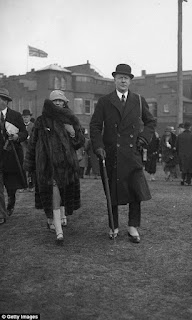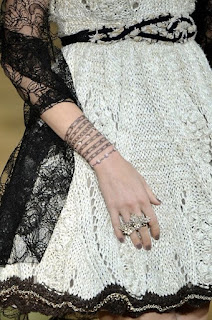Change the Chanel*
La revolucionaria francesa:
Cuando una persona escucha la palabra moda, es altamente probable que se le crucen diversas cosas por la cabeza, pero lo que es seguro es que Chanel será una de ellas.
 |
| Courtesy of Pinterest. |
La emancipación de la mujer y la elegancia son dos de los pilares que indiscutiblemente llevan sosteniendo la marca desde sus mismísimos inicios, pues a pesar de todo, la historia de su fundadora nunca deja a ningún oyente indiferente.
A demás de haber sido el origen de todo el paradigma estilístico del periodo de entre guerras, rompiendo a su vez con el canon académico de la Belle Époque a través de sus trazos informales, ropajes masculinizados y la liberación tanto física como social de las mujeres, muchos no conocen su biografía en profundidad.
 |
| Courtesy of Pinterest. |
La infancia de la modista nacida en el seno de una familia desbaratada y pobre, estuvo lejos de ser agradable. A los doce años perdió a su madre a manos de la miseria y los continuos embarazos (Chanel tubo cuatro hermanos a los cuales pagó a cambio de que no tratasen de contactar de nuevo con ella). Tras esta tragedia, el padre de Gabrielle (su nombre de bautizo) la abandonó en un hospicio de monjas, lugar en que pasó seis años aprendiendo a coser hasta que su espíritu rebelde la condujo a desentenderse de dicho orfanato e ir en busca de aventuras independientes.
Así, con toda un pasado de fantasía que elaboró con el fin de soterrar su verdadera procedencia, terminó por frecuentar un bar destinado a la diversión de oficiales militares donde su típica interpretación de la canción “Ko ko ri ko y Qui qu’a vu Coco?” la valió su famoso apodo.
 |
| Courtesy of Pinterest. Gabrielle Chanel |
En este mismo lugar conoció al que terminaría por convertirse en su amante pocos años después, el hombre que la sustrajo del modo de vida provinciano que hasta entonces había seguido para presentarle las delicias del lujo: Étienne Balsan.
 |
| Courtesy of Pinterest. Gabrielle junto a Étienne |
No obstante, Madame Chanel no se dio por satisfecha con cumplir con el rol que se le otorgaba al sexo femenino por aquel entonces, por lo que quiso abrir su propia sombrerería con Balsan como fuente de financiamiento. Pero, mientras que esté sopesaba la propuesta, Coco decidió fugarse con el que sería su gran amor perdido: Arthur Boy Capel. Sin embargo, había un pequeño gran inconveniente en su idilio romántico, Boy no disponía de un solo centavo, motivo por el cual la protagonista recurrió de nuevo a los privilegios económicos del acomodado Étienne, logrando de ese modo instalar su primera casa de modas.
 |
| Courtesy of Pinterest. Gabrielle sobre los hombros de Capel |
Esta, adquirió una gran fama de forma exponencial, e incluso a partir de este momento el paladar de Gabrielle no hizo otra cosa que seguir saboreando el dulce sabor del éxito. Hasta que en 1929 el crack de Wall Street condujo a su imperio a una grave recesión. A este le siguieron otros infortunios de diversos caracteres, la muerte de su pareja Paul Iribe, el estallido de la Segunda Guerra Mundial, su ruptura debida a su incapacidad de gestar hijos con el duque de Westminster y la acusación de colaboracionismo que la condujo al exilio en Suiza.
 |
| Courtesy of Pinterest. Gabrielle y el duque de Westminster |
Ahora bien, si hay algo que no deja lugar a dudas es el implacable espíritu de la couturier. El mismo que le condujo a reabrir sus salones a la impresionante edad de setenta años, donde pasó el resto de sus días entre alfileres y maniquíes hasta que el 10 de enero de 1971, tras un fatigoso paseo junto a su amiga Claude Baillen, se tendió en la cama para no volver a levantarse, dedicándole a esta sus últimas palabras: “Mira, así se muere.”
 |
| Courtesy of Pinterest. Gabrielle junto a una modelo |
 |
| Courtesy of Pinterest. Gabrielle Chanel |
El legado de esta imponente francesa es muy amplio, pero entre las huellas más significativas que su paso ha dejado en el mundo son el pequeño vestido negro, el cual se popularizó cuando Chanel fue vista durante diversos años vistiendo de luto al llorar la muerte de Boy Capel.
 |
| Courtesy of Pinterest. Coco Chanel |
 |
| Courtesy of Pinterest. Audrey Hepburn en “Desayuno con diamantes” |
También es digno de admirar como una de las mayores críticas que recibió la diseñadora por parte de su contrincante Paul Poiret, es una de las facetas más características de la adorada marca: la “pobreza chic”, que viene a referirse al uso de materiales humildes tradicionalmente reservados para la clase trabajadora como el punto, la lana o el algodón, y es que después de todo, podemos decir que esta pionera inyectó en el mercado textil la raíz del desarrollo de todas esas confortables prendas que actualmente utilizamos con tanta frecuencia (algunos con demasiada incluso).
 |
| Courtesy of Pinterest. Chanel |
Por otro lado, la causante de las icónicas faldas tipo midi de Chanel es lo horrendas que para la diseñadora sentía hacia las rodillas, considerándolas como la parte más antiestética de la anatomía humana.
 |
| Courtesy of Pinterest. Coco y una modelo |
Y, por supuesto, como ha sido mencionado al inicio del discurso, es imposible omitir como el hábito de robarle prendas a su querido Étienne Balsan se convirtió en la chispa que prendió la revolución andrógina que experimentamos hasta la actualidad, pues con este movimiento no sólo se ganó a favor de los derechos de la mujer, sino también de su comodidad: bolsos de cadena larga en vez de los poco prácticos estuches de mano, pantalones, la reinvención de ropa atlética propiamente masculina, etc. Una mujer hecha a si misma.
 |
| Courtesy of Pinterest. Gabrielle en un atuendo masculino |
 |
| Courtesy of Pinterest. Chanel |
À bientôt,
Le Chaos.
The French revolutioner:
When anybody ears the word fashion, it is highly probable that different things come to mind, but what is certain is that Chanel will be one of them.
 |
| Courtesy of Pinterest. |
The emancipation of women and elegance are two of the pillars that have indisputably supported the brand since its very beginnings, because despite everything, the story of its founder never leaves any listener indifferent.
Apart from having been the origin of the entire stylistic paradigm of the in-between-wars period, breaking in turn with the academic canon of the Belle Époque through its informal lines, masculinized clothing and the physical and social liberation of women, many do not know her biography in depth.
 |
| Courtesy of Pinterest. |
The dressmaker's childhood, born into a broken and poor family, was far from pleasant. At the devastating age of twelve years old she lost her mother at the hands of misery and her continuous pregnancies (Chanel had four brothers whom she paid in exchange for not contacting her ever again). After this tragedy, Gabrielle's father (her baptismal name) abandoned her in a nuns' hospice, where she spent six years learning to sew until her rebellious spirit led her to disengage from the orphanage and go in search of independent adventures.
Thus, with a whole made up past that she elaborated in order to bury her true origin, she ended up frequenting a club intended for the entertainment of military officers where her typical interpretation of the song “Ko ko ri ko and Qui qu'a vu Coco ?” earned her the famous nickname.
 |
| Courtesy of Pinterest. Gabrielle Chanel |
In this same place she met the one who would end up becoming her lover a few years later, the man who took her away from the provincial way of life that she had followed until then to introduce her to the delights of luxury: Étienne Balsan.
 |
| Courtesy of Pinterest. Gabrielle next to Étienne |
However, Madame Chanel was not satisfied with fulfilling the role that was granted to the female sex at that time, and so she wanted to open her own hat shop with the financial help of Balsan. But, while he was considering her proposal, Coco decided to elope with what would be her great lost love: Arthur Boy Capel. Nonetheless, there was a small inconvenience in her romantic idyll, Boy did not have a single penny, which is why the protagonist resorted again to the economic privileges of the wealthy Étienne, thus managing to install her first fashion house.
 |
| Courtesy of Pinterest. Capel and Coco Chanel |
The business acquired great fame exponentially, and from this moment Gabrielle's palate did nothing but continue to savor the sweet taste of success. Until in 1929 the Wall Street crash drove her empire into a serious recession. This was followed by other misfortunes of various kinds, the death of her partner Paul Iribe, the outbreak of World War II, her breakup due to her inability to conceive children with the Duke of Westminster and the accusation of collaboration with the nazis that led her into exile in Switzerland.
 |
| Courtesy of Pinterest. Chanel and the duke of Westminster |
Now, if there is something that leaves no room for doubt, is the relentless spirit of the couturier. The same one that led her to reopen her salons at the impressive age of seventy, where she spent the rest of her days between pins and mannequins until on January 10, 1971, after a tiring walk with Claude Baillen, she laid down in bed to never get up again, dedicating her last words to her friend: "Look, this is how you die."
 |
| Courtesy of Pinterest. Chanel working with a model |
 |
| Courtesy of Pinterest. Coco Chanel |
The legacy of this imposing French woman is very broad, but among the most significant traces that her passage has left in the world are the little black dress, which became popular when Chanel was seen for several years wearing mourning to mourn the death of Boy Capel.
 |
| Courtesy of Pinterest. LBD |
 |
| Courtesy of Pinterest. Princess Diana with her revenge dress |
It is also worth admiring how one of the biggest criticisms the designer received from her opponent Paul Poiret, is one of the most characteristic facets of the beloved brand: “chic poverty”, which refers to the use of humble materials traditionally reserved for the working class such as knitwear, wool or cotton, and after all, we can say that this pioneer injected into the textile market the root of the development of all those comfortable garments that we currently use so frequently (some too much even).
 |
| Courtesy of Pinterest. Chanel |
On the other hand, the cause of the iconic Chanel midi skirts is how horrendous the designer felt towards the knees, considering them the most unsightly part of the human anatomy.
 |
| Courtesy of Pinterest. Chanel |
And, of course, as has been mentioned at the beginning of the speech, it is impossible to omit how the habit of stealing clothes from his beloved Étienne Balsan became the spark that ignited the androgynous revolution that we are experiencing to this day, because with this movement not only was won for women's rights, but also for their comfort: long chain bags instead of impractical clutches, pants, the reinvention of properly masculine athletic clothing, etc. A self made woman.
 |
| Courtesy of Pinterest. Coco wearing masculine clothes |
 |
| Courtesy of Pinterest. Chanel |
À bientôt,
Le Chaos.


Comentarios
Publicar un comentario